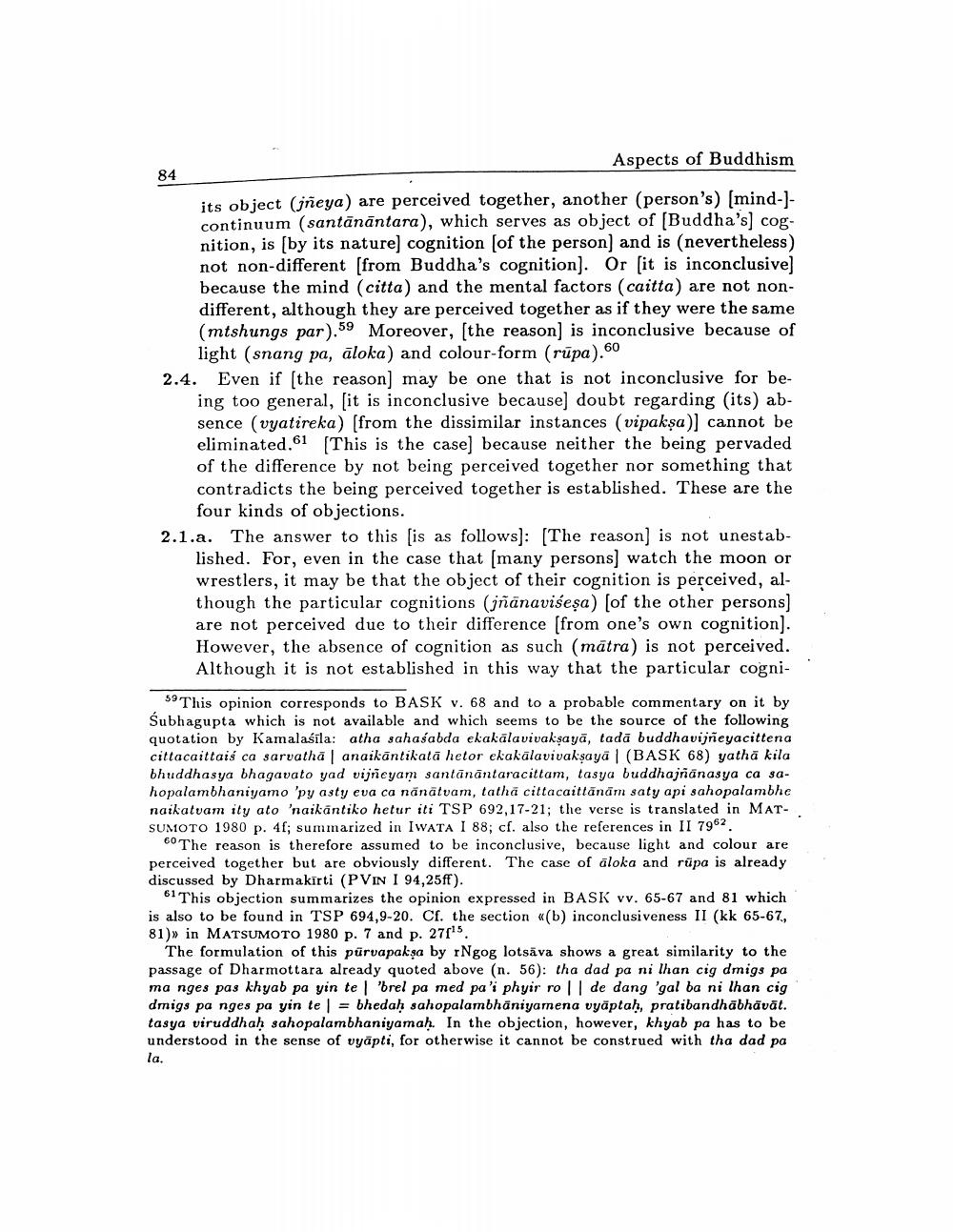________________
Aspects of Buddhism 84
its object (jñeya) are perceived together, another person's) (mind-)continuum (santānāntara), which serves as object of Buddha's) cognition, is (by its nature) cognition (of the person) and is (nevertheless) not non-different (from Buddha's cognition). Or (it is inconclusive) because the mind (citta) and the mental factors (caitta) are not nondifferent, although they are perceived together as if they were the same (mtshungs par).59 Moreover, (the reason) is inconclusive because of
light (snang pa, aloka) and colour-form (rūpa).60 2.4. Even if [the reason) may be one that is not inconclusive for be
ing too general, (it is inconclusive because] doubt regarding (its) absence (vyatireka) (from the dissimilar instances (vipakşa)] cannot be eliminated.61 (This is the case because neither the being pervaded of the difference by not being perceived together nor something that contradicts the being perceived together is established. These are the
four kinds of objections 2.1.a. The answer to this sis as follows]: [The reason) is not unestab
lished. For, even in the case that (many persons) watch the moon or wrestlers, it may be that the object of their cognition is perceived, although the particular cognitions (jñānaviseșa) (of the other persons) are not perceived due to their difference (from one's own cognition). However, the absence of cognition as such (mātra) is not perceived. Although it is not established in this way that the particular cogni
59 This opinion corresponds to BASK v. 68 and to a probable commentary on it by Subhagupta which is not available and which seems to be the source of the following quotation by Kamalasila: atha sahasabda ekakālavivakṣayā, tada buddhavineyacittena cittacaittais ca sarvatha | anaikāntikatā hetor ekakālavivakşayā 1 (BASK 68) yathā kila bhuddhasya bhagavato yad vijneyam santānāntaracittam, tasya buddhajnanasya ca sahopalambhaniyamo 'py asty eva ca nănātvam, tathā cittacaitlānām saty api sahopalambhe naikatvam ity ato 'naikantiko hetur iti TSP 692,17-21; the verse is translated in MATSUMOTO 1980 p. 4f; summarized in IWATA I 88; cf. also the references in II 7962.
6. The reason is therefore assumed to be inconclusive, because light and colour are perceived together but are obviously different. The case of aloka and rüpa is already discussed by Dharmakīrti (PVIN I 94,25ff).
61 This objection summarizes the opinion expressed in BASK vv. 65-67 and 81 which is also to be found in TSP 694,9-20. Cf. the section «(b) inconclusiveness II (kk 65-67, 81) in MATSUMOTO 1980 p. 7 and p. 27115
The formulation of this purvapakşa by rNgog lotsāva shows a great similarity to the passage of Dharmottara already quoted above (n. 56): tha dad pa ni lhan cig dmigs pa ma nges pas khyab pa yin tel 'brel pa med pa'i phyir rol de dang 'gal ba ni lhan cig dmigs pa nges pa yin te l = bhedah sahopalambhāniyamena vyāptah, pratibandhābhāvāt. tasya viruddhah sahopalambhaniyamah. In the objection, however, khyab pa has to be understood in the sense of vyāpti, for otherwise it cannot be construed with tha dad pa
la.




